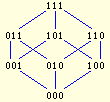Isoperimetric Tools
Poset Test for Macaulayness
This tool checks whether or not a given ranked poset is Macaulay.
The poset is defined by its covering relation, which should be encoded in
a file located on your computer (the encoding instructions are below).
In order to run the test, upload the poset encoding file to the server.
The tool checks whether the poset is ranked and in this case displays its
Hasse diagram. If the poset is Macaulay, the elements within each level
will be ordered from left to right in increasing Macaulay order. The order
itself can be displayed by clicking the corresponding button on the top of
the Hasse diagram.
Currently, the tool is in beta-version. Only posets with up to
30 elements are accepted by the tool.
Select a file to upload
Poset encoding instructions
The poset file is a text (ASCII) file with the number of lines equal to the
number of poset elements, that is one line per element. For each element
p of P the corresponding line must contain the following information on p:
label
label1 label2 . . .
labelk
Here:
label is the label of p
(a string consisting of letters, digits or underscores only)
label1 label2 . . .
labelk is a list of labels of vertices covered
by p. If p covers no other vertex, this list is empty.
Moreover, the file must satisfy the following claims:
- The file size must not exceed 50 kilobytes.
- The parameters within one line must be separated by one or more spaces.
- Empty lines are ignored.
- A portion of a line followed by the # sign is considered as a comment
and ignored. The comments are optional.
Example
| Poset | Encoding | Comments |
|---|
 |
000 # the bottom vertex
001 000 # first level
010 000
100 000
011 001 010 # second level
101 001 100
110 010 100
111 011 101 110 # the top level
|
000 is the label
empty line, ignored
vertex 001 covers 000
vertex 010 covers 000
vertex 100 covers 000
vertex 011 covers 001 and 010
vertex 101 covers 001 and 100
vertex 110 covers 010 and 100
the top vertex covering 3 other vertices
|
Check Gallery of Posets for more
examples.
Last modified:
Mon, Jan 23, 2023.








